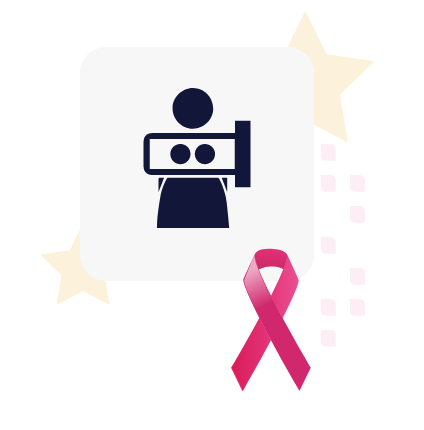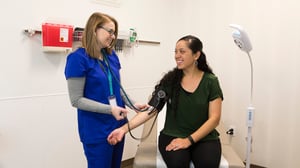With the start of fall upon us, October is known across the country as national Breast Cancer Awareness Month. Created to draw attention to the importance of breast cancer screening, this year, increased awareness for this issue is even more important than ever. With a decrease in breast cancer screenings being completed due to the COVID-19 pandemic, Breast Cancer Awareness Month is a great reminder for everyone to connect with their primary care providers to ensure that they are scheduled for routine preventive screening, sooner rather than later.
According to the National Cancer Institute, 12.9% of all women born in the United States will be diagnosed with breast cancer at some point in their lifetime. That gives the average American woman roughly a 1 in 8 chance of developing this disease.
Looking to learn more about the rising prevalence of breast cancer, we sat down with Dr. Robert Vance, D.O., to discuss how improved awareness and education can lead to better health outcomes for women across the country.

Q: What is Breast Cancer Awareness Month and how has it led to positive change?
Dr. Vance: Founded in 1985 by the American Cancer Society, Breast Cancer Awareness Month was actually kicked off by Betty Ford, wife of 38th President Gerald Ford. As a breast cancer survivor herself, the goal of starting this initiative was to increase awareness of the condition while also encouraging women to comply with regular mammography testing. Now, Breast Cancer Awareness Month has subsequently been championed by many charities and is used to fundraise, increase research, enhance preventative screening, and hopefully, one day find a cure.
Over the past 36 years, Breast Cancer Awareness Month has gained a ton of national and global support, from many fundraising 5K runs and the creation of the pink ribbon that is now synonymous with the disease. Helping to empower and support women during this stressful time is essential for them to have the best possible outcomes, and we believe that Breast Cancer Awareness Month has helped women living with this disease to feel less alone.
Q: How common is breast cancer compared to other cancers in the United States?
Dr. Vance: Unfortunately, on top of being the most common female cancer, this last year breast cancer took over to become the most common cancer in the world. In 2021, the NIH predicts more women will be diagnosed with breast cancer than any other cancer worldwide, which is deeply concerning.
On top of this, breast cancer seems to be more prevalent in the United States than in other countries. While we aren’t fully sure why this is, one suggestion is that America is quite good at diagnosing breast cancer (there are many available mammogram clinics, some of which are mobile and able to go directly to patients in need). Increased rates of obesity, exposure to irritants and pollution, and the use of hormonal replacement therapies are also possible causes for the increased number of cases here.
And while this may seem all doom and gloom, it is important to note that of the 3.8 million women living in the United States with breast cancer, only 2.5% of them will pass away as a result of the disease. This high survivability rate is a result of increased awareness and improved treatment options created from research that was in part funded by this initiative.

Q: Is there an age range that women should start factoring in breast cancer screenings, and if yes, what does the frequency look like? How frequently should women be having these screenings?
Dr. Vance: Based on the two leading resources on breast cancer screenings, the general consensus is to begin breast cancer screening in women at the age of 50. Typically, screening should take place every year or two up until the age of 75, though these numbers can be stretched or changed depending on the individual.
For example, in my practice, we screen women over 50 every two years if they:
- Don’t have a family history of breast cancer
- Have no medical comorbidities (or they are well controlled)
- Have not noticed any lumps or changes to their breast tissue
Women with any of the above symptoms will be screened more frequently, and we may even start screening as early as 40. Performing self-breast exams on a regular basis has not been shown to reduce mortality from earlier detection of breast cancer but it is essential to help women bring their concerns to my attention, so we can get them in for a mammogram to better understand what is going on.
Q: What is a mammogram?
 Dr. Vance: Mammograms are currently the gold standard for breast cancer screening in the United States. I know many women are very nervous to have them done (often from discomfort, exposure to radiation, and general lack of information), but with technology improving the application [use] of mammography at a rapid rate, they are truly a very safe and effective tool. Many women ask me about different types of breast cancer screening tools such as MRIs, which can also be used. While each type of testing has their own unique benefits and limitations, I highly recommend talking with your provider about which style of testing is the best match for your unique needs.
Dr. Vance: Mammograms are currently the gold standard for breast cancer screening in the United States. I know many women are very nervous to have them done (often from discomfort, exposure to radiation, and general lack of information), but with technology improving the application [use] of mammography at a rapid rate, they are truly a very safe and effective tool. Many women ask me about different types of breast cancer screening tools such as MRIs, which can also be used. While each type of testing has their own unique benefits and limitations, I highly recommend talking with your provider about which style of testing is the best match for your unique needs.
We highly recommend that women keep up with screenings to stay on top of any potential changes in their breast tissue. Early detection is essential for early diagnosis, so we really try to help women feel less fear and hesitancy when it comes to getting a mammogram done.
Q: Outside of the screenings, what are the everyday steps women can take to reduce their likelihood of developing breast cancer?
Dr. Vance: Cancer is not caused by one single risk factor. Genetics, lifestyle habits, environmental factors, and more all contribute to a positive diagnosis of breast cancer.
While you cannot change your genetics, there are other lifestyle habits you can incorporate to keep your body healthy and reduce the risk of developing breast cancer. Some examples include:
- Eating a nutritious diet (I tell my patients to eat the color of the rainbow in their fruits and vegetables)
- Participating in regular low impact exercise
- Prioritizing your sleep schedule
- Reducing your exposure to chronic stress via mindful meditation, a concept we teach at Vera Whole Health with our coaching model
Q: If members have a loved one who is navigating breast cancer or has had it previously, are there thoughts or tips that members can use to help loved ones feel supported?
Dr. Vance: This is never an easy task. First and foremost, allowing your loved one adequate amounts of time to process the diagnosis for themselves is crucial. They will be feeling a lot of different feelings all at once, and you want to avoid overwhelming them.
As they process this new information, it is very normal for them to experience a wide range of emotions, from anger, frustration, sadness, and even apathy. So while they are going through all of this, the most important thing I tell the family and friends of my patients is to show up for them. Empathy, support, and just spending time with them while they navigate their new normal is more valuable than you may ever know. You want them to feel like they aren’t having to go through this alone, so do your best to show up and support them whenever possible.
At Vera, we want to help every one of our patients feel supported throughout their journey to better health. Whether you need to see a Vera provider for a health care appointment or a referral for breast cancer screening, call today to schedule your next appointment.
Schedule an appointment to talk with your Vera provider at patients.verawholehealth.com.
Sign up
Join our email list to receive the latest open positions, Vera Careers news, and more.




